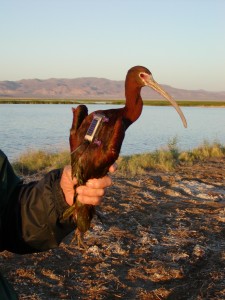
White-faced ibis with PTT package
Earthspan principals led a cooperative study to identify the source(s) of DDT-related contamination still plaguing a northern Nevada population of white-faced ibis many years after use of the pesticide was banned in the United States.
The white-faced ibis (Plegadis chihi) is a long-legged wading bird that feeds primarily on invertebrates in wetlands and irrigated croplands. It is a highly social colonial nester and often forages in large aggregations. Due to restricted nesting habitat and potential vulnerability to pesticides, the species is listed by the U.S. Fish and Wildlife Service as a migratory non-game bird of management concern.
Dr. Charles Henny (U.S. Geological Survey; USGS) documented continued troubling levels of DDE (the principal metabolite of the organochlorine pesticide DDT) in a large segment of the white-faced ibis population nesting at Carson Lake in western Nevada. Of twenty eggs collected in 1996, 45% contained >4 ppm DDE, and eggshells averaged 18.3% thinner than normal. This represented no improvement from DDE levels documented in 1985-86, which is contrary to patterns shown for most other avian species in the USA. Analyses of upper digestive tract contents in 18 Carson Lake ibis revealed no organochlorine insecticides; the conclusion was that contamination is not occurring on the Nevada breeding grounds. Identification of contaminant sources was highly desirable because it is likely that different regional cohorts of ibis and other wildlife species are frequenting those same areas.
We captured and blood sampled ibis, then tracked them to wintering locales via satellite-received telemetry. We visited wintering sites to collect earthworms, and analyzed them and the original ibis blood samples for DDE. Birds with highest contamination wintered in the Mexicali Valley of Baja Norte, Mexico, and highest DDE levels were also found in earthworms collected at those corresponding wintering areas. Our findings were published in 2010.Yates etal WFIB DDE 2010 Ecotoxicology
